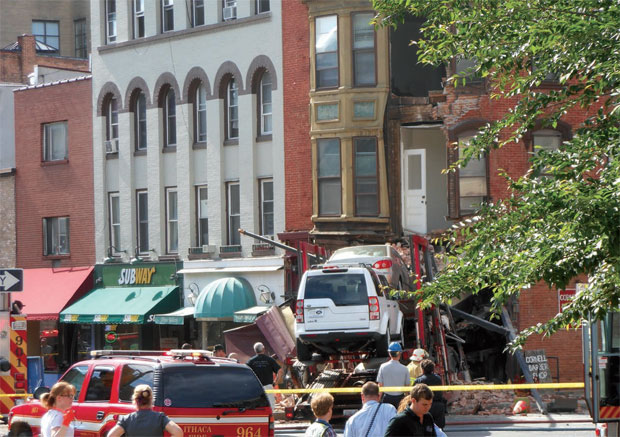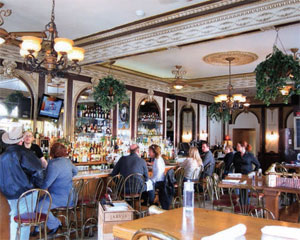Ithaca Mayor Svante Myrick ’09 was at the Ithaca Farmers’ Market when he got the text. It was around 4 p.m. on Friday, June 20, and it was his last appointment of the week: the rehearsal for a wedding at which he was officiating the next day. “Tractor trailer has slammed into Simeon’s,” the message said. “It looks pretty bad.”
Myrick sprinted from the site of the nuptials—the dock that juts into Cayuga Inlet—just as the bride was processing in his direction. “I ran past her and said, ‘I’ll explain later. I’ll see you tomorrow. It’ll be OK,'” Myrick recalls, sitting in his City Hall office nearly a month and a half later. “She was a little freaked out.”

Disaster area: After losing its brakes on East Hill, a runaway tractor trailer smashed into the end of the Commons.
So were we all. What unfolded was a heartbreaking, deeply unsettling, oddly uplifting few days—a series of events that brought the city together in ways that felt quintessentially Ithacan. A senseless accident destroyed a local landmark, put dozens of people out of work, and—most tragically—took the life of a twenty-seven-year-old woman, the mother of a toddler. Days later, the news got worse: she was pregnant. The death toll doubled.
At CAM, we didn’t hear the crash, which is rather astounding considering that our offices are just a block from the intersection of State and Aurora streets. And the sound—of a twentyton car hauler striking the corner of Simeon’s restaurant at nearly fifty miles per hour after losing its brakes on East Hill—must have been deafening. If we craned our necks, we could see the aftermath from our windows: the legions of police and firefighters; the heavy construction equipment; the throngs of onlookers snapping cell-phone pictures; the memorial shrine; the traffic barriers that blocked off Aurora Street for weeks afterward. “At first it was chaos,” Myrick recalls. “We didn’t know how many people were inside. We didn’t know if the building was going to collapse.”
City engineers rushed over to inspect the scene. The truck had gone all the way into the restaurant and damaged the wall of the building next door, which houses an artist’s gallery. “We were afraid that if we pulled it out, the rest of the façade would collapse,” Myrick recalls, “and the weight of the bricks would make the truck fall into the basement.” A local construction company brought equipment down from a job site in Collegetown; the building’s roof was peeled back, its teetering front corner demolished. It took four tow trucks— including two “superhaulers”—to wrest the smashed semi from Simeon’s interior. Amazingly, one of the cars it was transporting— a white Range Rover—didn’t have a scratch on it. But as the construction claw was transferring the last load of debris from the building, a beam fell on it and cracked the windshield. In the end, nothing emerged unscathed.

Ithaca mayor Svante Myrick ’09 with an Ithaca Fire Department official.
When Myrick got that text, he was sure he was heading to a mass-casualty scene. And even as the community mourned Simeon’s bartender Amanda Bush and her unborn child, we all knew it could have been far worse. If it had happened an hour later—when revelers were streaming into Restaurant Row—the death toll almost certainly would have been higher. The infrastructure renovations that have disrupted the Commons for two straight summers suddenly had an upside: there were far fewer people hanging out on a lovely afternoon. The driver reportedly hit Simeon’s after swerving to avoid construction workers directly ahead of him.
Sitting at the foot of East Hill, the handsomely detailed nineteenth-century building that houses Simeon’s is a familiar site to Ithacans and visitors alike; when you get to the end of State Street, it’s the first thing that greets you. Simeon’s has fed and watered generations of Cornellians (and their check-paying parents), who’ve enjoyed classic American fare amid its plaster angels and marble bar. The business has changed hands several times over the decades; past owners include one of Myrick’s predecessors as mayor, Alan Cohen ’81, BS ’86. The quality of its offerings has varied, but the conventional wisdom among Ithaca foodies is that under its current regime, Simeon’s was at its culinary best. The restaurant’s future remains up in the air: while the city has deemed the building structurally sound, Myrick says, whether it’s ultimately demolished or restored will depend in large part on the outcomes of insurance claims.

The heavily damaged interior of the historic restaurant had been filled with period details.
The criminal case is ongoing, the civil ones sure to follow. The driver, who worked for a car-relocation company based in Washington state, was scheduled to appear in Tompkins County Court in August; he has pleaded not guilty to having an over-length vehicle and an inadequate braking system. The New York State Police’s accident investigation continues; depending on its findings, he could face more serious charges, including vehicular manslaughter. In the days following the crash, journalists struggled to sort out who actually owned the truck—which, it emerged, had a history of braking problems. As the Ithaca Journal reported, in the two years preceding the crash, “the safety records for the two trucking companies tied to the red Peterbilt were among the worst for all trucking companies in the nation.”
But the news organization that has covered the story best didn’t even exist until shortly before the accident. The Ithaca Voice—an online-only venture led by former Daily Sun managing editor Jeff Stein ’13—launched in June. After the tragedy, the Voice quickly emerged as an insightful, comprehensive source of information; it has gone on to investigate the truck’s corporate ownership, offer a forum for ideas to prevent future accidents, and more. Like CNN during the first Gulf War, the Simeon’s crash put the Voice on the map.
In the aftermath of the disaster, Myrick was at the scene until three the next morning. He conducted press conferences, fielded calls from CNN and NBC, helped establish a fund that has raised more than $70,000 for Bush’s family; all in all, he acted like the sort of civic leader you’d want when something awful happens. More than a month later, he still seems shaken. “It struck at the heart of our sense of security,” he says. “That intersection is the city’s center, geographically and culturally: east goes to Cornell, south to Ithaca College, north to the lake, west to downtown. It’s an intersection that any Ithacan could realistically have been walking through at four o’clock in the afternoon. For the next few weeks, all anyone could talk about was, ‘I was just there,’ ‘I was supposed to be there for dinner that night,’ ‘I was there the night before.'”
Actually, Myrick was there the night before. On Thursday, he stopped into Simeon’s to chat with some parents of incoming students at I.C.


